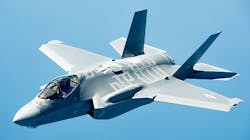F-35 fighter, P-8A patrol jet, KC-46 tanker are big winners in 2016 DOD budget proposal
WASHINGTON, 4 Feb. 2015. The U.S. military's F-35 Lightning II joint strike fighter (JSF) -- one of the nation's costliest defense programs -- leads efforts by the U.S. Department of Defense (DOD) to upgrade and build new military aircraft in the Pentagon's fiscal 2016 budget request, submitted this week.
In the 2016 DOD budget, U.S. military services are asking Congress for $11 billion next year to continue research and development of the F-35, as well as to build 57 new Lockheed Martin F-35 aircraft. Fiscal 2016 begins next October.
The JSF multi-service jet fighter bomber comes in several variants -- a long-runway variant for the U.S. Air Force, a carrier-based version for the U.S. Navy, and a short- and vertical-takeoff and landing version for the U.S. Marine Corps.
The F-35 has an advanced avionics suite with large cockpit displays, modern look-and-shoot pilot helmet-mounted displays, advanced radar systems, and electro-optical sensors that enable the aircraft to detect, track, and attack enemy aircraft without turning on the radar.
The Pentagon's 2016 request for F-35 aircraft is up substantially from this year's enacted level of $8.6 billion, which is for research, development, and building 38 new JSF aircraft.
Pentagon leaders in 2016 plan to buy 44 conventional-takeoff F-35 versions for the Air Force, nine jump-jet versions for the Marine Corps, and four carrier versions for the Navy.
The F-35, however, is far from the only lucrative aircraft program that seeks funding in the 2016 DOD budget. The Navy also is asking for $3.4 billion to buy 16 Boeing P-8A maritime patrol versions of the Boeing 737 passenger jetliner.
Boeing also is poised to be a big winner in a separate aircraft in 2016. The U.S. Air Force is asking Congress for $3 billion to buy 12 KC-46A aerial refueling tanker, which is a militarized version of the Boeing 767 widebody passenger jet.
The next largest military aircraft program proposed for fiscal 2016 is the joint-force Lockheed Martin C-130J utility turboprop aircraft. Next year the Pentagon is asking for $2.6 billion to buy 29 C-130J for tactical airlift of supplies and troops, a variety of special operations missions, and aeromedical evacuation and logistics support.
An emerging important military aircraft program is the future Air Force Long Range Strike aircraft, which will replace or augment the B-2 Spirit stealth bomber, the B-1 Lancer supersonic bomber, and the B-52 long-range bomber.
Related: Pentagon's proposed 2016 budget would increase military spending by $38.2 billion next year
Next year the Air Force is asking for $2 billion research and development for the next-generation Long-Range Bomber, as well as to upgrade and modernize existing Air Force strategic bombers.
The U.S. Army Sikorsky UH-60 Black Hawk helicopter also would be a big winner in the 2016 DOD budget. The Army is asking for $1.6 billion to buy 94 Black Hawk helicopters for moving troops, equipment, and supplies into comb at, as well as performing aeromedical evacuation.
Next on the list of big aircraft programs in the 2016 DOD budget is the joint-force Bell-Boeing V-22 Osprey tiltrotor aircraft. The Pentagon is asking for $1.6 billion to buy 19 Osprey aircraft for airborne assault, vertical lift, combat search and rescue, and special operations.
The joint-force large surveillance unmanned aerial vehicle (UAV) design by Northrop Grumman Corp., which makes up the U.S. Air Force and Navy RQ-4 Global Hawk and the U.S. Navy MQ-4 Triton maritime patrol drone also is a big winner in the 2016 budget. The Pentagon is asking for $1.4 billion next year to buy three Triton UAVs, as well as upgrades to the Block 30 and Block 40 Global Hawk UAV, ground stations, and multi-platform radar technology insertion.
The Navy, meanwhile, is asking for $1.3 billion to buy five Northrop Grumman E-2D Advanced Hawkeye carrier-based airborne early warning aircraft; the Army is asking for $1.4 billion to remanufacture 64 Boeing AH-64E Apache attack helicopters and $1.2 billion to buy 30 Boeing CH-47 Chinook heavy-lift helicopters; and the Navy is asking for $991.4 million for 29 Sikorsky MH-60R multi-mission helicopters.
In other major DOD aircraft programs, Pentagon agencies are asking for $402.1 million for 17 new MQ-1C Gray Eagle surveillance UAVs; $903.6 million to buy 29 MQ-9 Reaper attack UAVs; $280.8 million for seven RQ-7 Shadow/RQ-11 Raven/RQ-21 Blackjack small UAVs; $187.2 million for 28 Airbus UH-72 Lakota light utility helicopters; $883.4 million for 28 AH-1Z Viper attack helicopters and UH-1Y Venom utility helicopters; and $601 million to upgrade the Air Force fleet of Lockheed Martin F-22 Raptor jet fighters.

